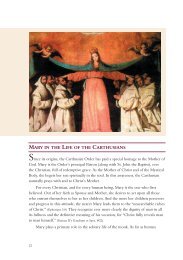Carthusian Saints (PDF) - Charterhouse of the Transfiguration
Carthusian Saints (PDF) - Charterhouse of the Transfiguration
Carthusian Saints (PDF) - Charterhouse of the Transfiguration
You also want an ePaper? Increase the reach of your titles
YUMPU automatically turns print PDFs into web optimized ePapers that Google loves.
to protect <strong>the</strong> Jews, great numbers <strong>of</strong> whom lived in Lincoln. He put<br />
down popular feelings against <strong>the</strong>m in several places.<br />
He had no scruple in following <strong>the</strong> custom <strong>of</strong> <strong>the</strong> times and admitting<br />
married women and widows to sit at his table; his biographer<br />
tells how he would sign <strong>the</strong>ir foreheads with <strong>the</strong> sign <strong>of</strong> <strong>the</strong> Cross as<br />
<strong>the</strong>y knelt before him and gently press <strong>the</strong>ir heads between his two<br />
palms.<br />
“God”, he would say, “well deserves to be loved by women,<br />
for He did not shun to be born <strong>of</strong> a woman. Marvelous and<br />
precious was <strong>the</strong> privilege He thus gave to all women. It was<br />
not granted to a man to be or to be called fa<strong>the</strong>r <strong>of</strong> God, but it<br />
was given to a woman to bear God.” (3)<br />
Hugh rarely left <strong>the</strong> Diocese, became personally acquainted with<br />
all his clergy, held regular canonical visitations and was most careful<br />
to choose men worthy <strong>of</strong> <strong>the</strong> care <strong>of</strong> souls. Once a year he returned to<br />
Witham <strong>Charterhouse</strong> to give himself to prayer.<br />
As pointed out already, with <strong>the</strong> kings Hugh was absolutely fearless.<br />
(During his episcopacy England had Henry II till 1189, <strong>the</strong>n<br />
Richard The Lion-Heart, 1189-1199, <strong>the</strong>n John Lackland from 1199.)<br />
He stood up to Richard’s violent temper when everybody else was<br />
afraid. In 1194 Saint Hugh excommunicated John Lackland. (4) Saint<br />
Hugh did not have a stern and gloomy character. His fearlessness<br />
made him relaxed when he was with kings. With a witty repartee he<br />
knew how to turn <strong>the</strong> royal anger into laughter.<br />
Ano<strong>the</strong>r element <strong>of</strong> his life still should not be left out: Hugh had<br />
a special affinity with animals. Birds and squirrels seemed attracted to<br />
his company. The most famous example <strong>of</strong> this affinity is <strong>the</strong> swan in<br />
his manor at Stow. This swan became both a pet and watchdog. From<br />
medieval to modern times artists have depicted Hugh with his pet<br />
swan. (5)<br />
He had poor health and in 1200 he had a premonition that his<br />
time was running out. He made a pilgrimage to <strong>the</strong> places in France<br />
where he had spent <strong>the</strong> first part <strong>of</strong> his life: <strong>the</strong> Grande Chartreuse, <strong>the</strong><br />
castle Avalon where he was born, and <strong>the</strong> canons regular. As we saw<br />
above, he also visited Saint Artold at Arvières. After returning to<br />
England, he did indeed become ill and died in London on November<br />
31





